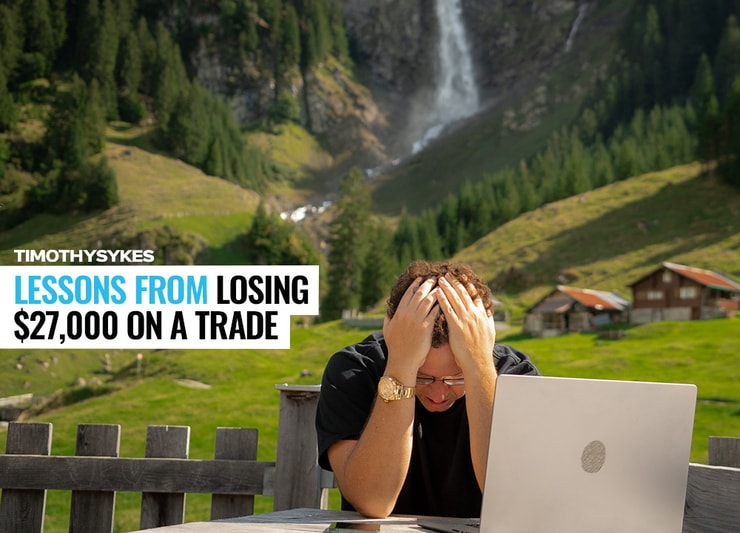I don’t think you can analyze your big losses enough.
Why?
Because you put yourself in a dangerous position.
And if you play with fire enough, your account will get burned…and go up in flames.
That’s why I want to talk to you more about my trade in EFTR from last Friday– my worst trade in decades.
I made a series of avoidable mistakes you can learn from.
And the best part is it won’t cost you $27K as it did me.
Back To Square One?

2025 Millionaire Media, LLCWhat is wrong with me?
I made six figures in profits last year in one of the hardest markets we’ve experienced in decades. The Dow, S&P 500, and Nasdaq all got destroyed.
I was really proud of my trading, even though I made over $1 million in 2020 and 2021.
But with the markets raging the way they’ve been…you’d think I’d be crushing it…but I’m not.
The worst part?
I would be okay if I didn’t make two bonehead trades this year…which have eaten almost all my gains in 2023.
First things first…
Slow down.
I know taking a big loss can make you feel sick inside. It’s how I felt last weekend.
And if you are competitive, you probably want to get that loss back as quickly as possible.
Right now, I’m trying to clear my head. And get back to basics.
But on Friday, after that EFTR loss, I didn’t stop.
In fact, I took three more trades after that.
Talk about being on full-tilt, right?
Accept Full Responsibility

2025 Millionaire Media, LLCI made many mistakes in EFTR.
Some of those mistakes were unfortunate.
For example, I was long a stock that announced a direct offering.
That’s just unlucky.
But if I rewind the tape…it should have never gotten to that stage.
To become a better trader, you must own your actions.
You can’t blame your broker, Jay Powell, or Ken Griffin for your losses.
More Breaking News
Taking Ownership
I got way too excited about the news in EFTR.
If you’ve followed me, you know that morning panic dip buys have been my best trades.
EFTR wasn’t one of those plays.
In fact, I was trying to play a breakout.
This is super risky, and it’s hard to manage risk when a stock is already up so much. It can have a sharp sell-off, bounce right back, and resume the uptrend.
That’s why I would rather be a buyer on weakness most of the time.
But I thought the news was just too good…and biotechs have been sizzling lately.
However, the mistakes I made were inexcusable…
Let’s run them down quickly:
- I got in during the pre-market. There’s nothing wrong with trading pre-market or even after hours. But you must also understand that it’s much more volatile than regular trading hours. That’s because volume tends to be lighter, and spreads tend to be wider. In addition, there are no volatility halts. That means stocks can go on wild rides without them being halted.
- It’s very hard to play breakouts in the pre-market. You don’t know how a stock will open up. It didn’t matter because the company announced a stock offering while I was in the trade, so I never got a chance to see how it opened.
- Trying to buy what I thought was the breakout quickly, I fat-fingered the trade, and instead of buying 8,000 shares, I bought 80,000 shares. Knowing I made a mistake, I should have exited the trade. Or at least sell 72K shares to reach my desired entry level. But the stock was selling off, and I didn’t want to start my Friday with a loss.
- The stock kept selling off. This didn’t make much sense considering how bullish the news was. Plus, two Wall Street firms came out and gave it a high price target, I think it was $7.
- But I made a massive blunder. Not only was I adding to the position, getting to the point of 181,000 shares…I was so dialed in…I totally forgot to look at my news feed. Had I been paying attention to it, I would have seen the headline on the $7.5 million direct offering.
- I traded too big…too aggressively…and it wasn’t even my best setup.
What can I say…I did A LOT of DUMB stuff.
This loss is a stain I’ll wear for a few weeks, possibly even months.
But I’ll be fine.
Honestly, I’m glad this happened to me and not to one of my students.

Final Note

2025 Millionaire Media, LLCLet my $27,000 misfortune be a cautionary tale for all of you. Learn from this massive blunder I paid a heavy price to bring you.
Trading is a marathon, not a sprint. You’ll have setbacks along the way.
Will you learn from your mistakes like I plan to do…or will you self-sabotage like most people who try to trade?
I’ve helped over 30 of my students on their journey to becoming millionaire traders…if you think you should be next…









Leave a reply